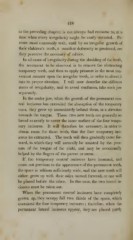Page 422 - My FlipBook
P. 422
418
in the preceding chapter, is not always had recourse to, at a
time when every irregularity might be easily obviated. Pa-
rents most commonly wait, until by an irregular growth of
their children's teeth, a manifest deformity is produced, ere
they perceive the necessity of advice.
In all cases of irregularity during the shedding of the teeth,
the treatment to be observed is to remove the obstructing
temporary teeth, and then to apply pressure in the most con-
venient manner upon the irregular tooth, in order to direct it
into its proper situation. I will now describe the different
states of irregularity, and to avoid confusion, take each jaw
separately.
In the under jaw, when the growth of the permanent cen-
tral incisores has exceeded the absorption of the temporary
ones, they grow up immediately behind them, in a direction
towards the tongue. These two new teeth are generally so
broad as nearly to cover the inner surface of the four tempo-
rary incisores. It will therefore be necessary, in order to
obtain room for these teeth, that the four temporary inci-
sores be extracted. The teeth will then gradually come for-
ward, in which they will naturally be assisted by the pres-
sure of the tongue of the child, and may be occasionally
helped by the fingers of the parent or nurse.
If the temporary central incisores have loosened, and
come out previous to the appearance of the permanent teeth,
the space is seldom sufficiently wide, and the new teeth will
either grow up with their sides turned forward, or one will
be placed before the other. In this case, the two lateral in-
cisores must be taken out.
When the permanent central incisores have completely
grown up, they occupy full two thirds of the space, which
contained the four temporary incisores ; therefore, when the
permanent lateral incisores appear, they are placed partly


